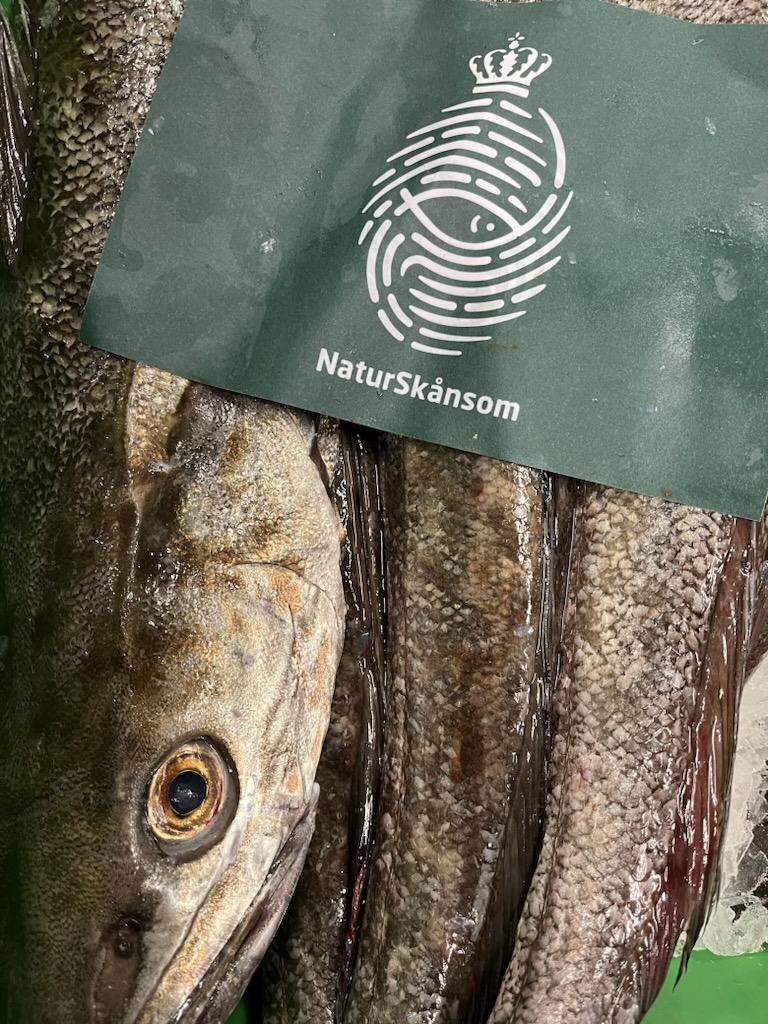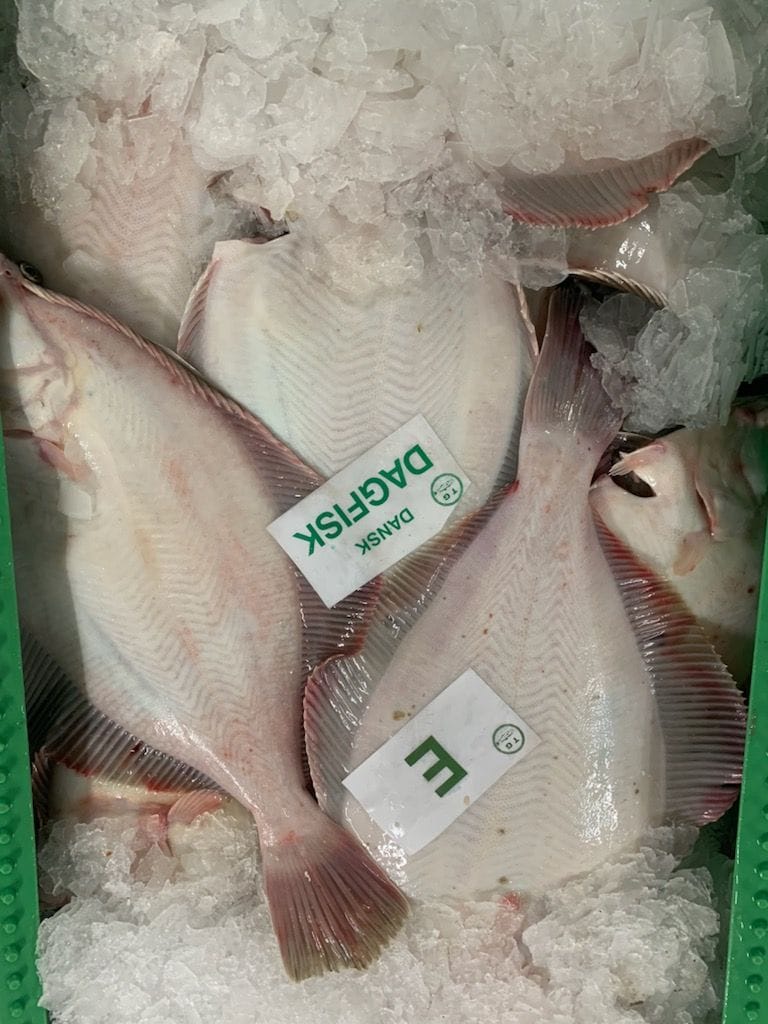September seasonal fish of the delightfully splendid kind.

From well-fed hake and plump mackerel — those black-striped bandits — to lobster, fjord shrimp, and crayfish: late summer is overflowing with delicious seafood. The beach is in season, but prices are sky-high. Mackerel are peaking in both flavour and numbers, and fjord shrimp are bigger and tastier than at any other time of year. We're also keeping an eye out for the first sea bass, turbot, brill, and red gurnard — and we'll tell you why right now is the time to get the best the sea has to offer on your menu.
Hake
The first one we need to talk about is hake!
There's been plenty of them, and they haven't been expensive. Fishing has been very close to shore, and the shark this year has been unbelievably well-fed. Beautiful, thick hake give a really high yield — something everyone loves. So you should definitely get on the menu right now and keep them there all the way through October.

Plaice
It's a different story with our beloved beach!
It's a different story with our beloved beach! They're in season, and they're beautifully fat from the West Coast — but expensive! Absurdly expensive, in fact. Plaice fillet No. 2 is almost unaffordable right now. A on nature's behalf, that doesn't really help. Ne.
It's not unusual for plaice stocks to fluctuate a lot — we've mentioned this before in our Updates — but the fact that there are virtually no plaice being caught inshore in the German, Belgian, Dutch, or Danish part of the North Sea is unusual.
The reasons are many. Fishing with beam trawls and bottom trawls in vulnerable coastal habitats is certainly one of them, but the fishery isn't solely to blame. There are also excessive discharges of nitrogen and other pollutants — which aren't even factored into official assessments of their health, even though they are measured. Add to that seals and cormorants — both protected — that also love a good plaque.
So it's the same culprits we keep talking about, not just fishing. Fact is you need to go far offshore to find large concentrations of plaice, and that limits fishing opportunities — whether stocks are on an upswing or a downswing. Rightfully now, we're in a downswing, although the species is still classified as “Least Concern” by the IUCN, the lowest threat category a species can have.
Still, this has a big impact on price because plaice isn't just one of our own classics — it's also a hugely popular fish in other countries fishing the North Sea, especially Germany and the Netherlands. That's why plants get so insanely expensive in summer, even when they're in season.
Our advice: keep it on the menu through November. They're delicious, and we expect prices will gradually drop to a more reasonable level during August.

Mackerel
Now, let's move on to mackerel!
The lovely trap-net mackerel took a long time to get going this year. Práce, as we mentioned last month, was that the big trap nets in Skagen were clogged with that ever-present fatty dung (slimy algae). Unfortunately, there's still quite a lot of fatty dung around Skagen, but it's improved since last time.
In early August, we've even been lucky enough to get some sardines in the trap nets — and if you get the chance to serve them, you really should.
Mackerel have also arrived along other Danish coasts, and you can catch them in Copenhagen Harbour and at many other spots along the coastline — if you're the type who likes to swing a fishing rod.
August and September are the absolute peak months for mackerel — both in numbers and in quality. You won't find better mackerel than those in August and September. They're perfectly fatty without being too much.
So get them on the menu — the black-striped bandits!

Lobster
Lobster from the sea!
It's no secret there are more and more lobsters along the Danish coast, and this year has been fantastic. That means there's been a good supply at the auctions most days during the summer — despite Limfjord, where most lobsters are caught, being closed.
That's great news for all of us who love lobster — so we recommend getting it on the menu now, so it can stay there through September, when the fjord opens again and even more lobsters come in.
Crayfish
Another member of the delicious “crawlies” gang is also in season — crayfish!
There's a good supply of Danish crayfish right now, and we'll have them well into October. We boil almost all of them — and we do it well! Uncle Frede has boiled more crayfish than you have, guaranteed, and he'll be at it from Monday to Friday. So remember to order your weekend crayfish for Friday delivery — because the boiler is closed on Saturdays!
Ours crayfishes (spinycheek crayfish a signal crayfish) a. When we have the native ones, we're happy to sell them live — but otherwise it's unfortunately illegal to sell live crayfish.
You can trust Uncle Fred's skills as a boil master — he's done it many, many times before!
Fjord shrimps
Last but not least, we have to mention the Fjord Shrimp — which are truly at their peak right now.
Yes, you heard right: now is the best time for Fjord Shrimp. Theyve already spawned their next generation for the second time this year, and now all they have to do is feed and fatten up without thinking about reproduction until next spring.
That's why they're so big right now — and they taste better and more intense now than they do in asparagus season.
So you might think... isn't it a shame not to have them on the menu? Och svar är: Sí, det er!
If you don't believe us, just order a batch and taste for yourself!

The rest of the stars
Other fish at their best right now and coming during the month...
It's time for red gurnard! We can't say for sure how many we'll get, but we'll buy every one we can find — even though few are caught with low-impact gear.

Turbot and brill are in top form. They're recovering from spawning, and some may still have a little roe, but they're still stunning. Ew ne.
Tas, a. In recent years, it hasn't been, so the gillnetters are fishing for other species — like hake — that can be caught just a couple of hours from port.
Sea bass should also be arriving soon. Last year, there were plenty of Danish sea bass in both August and September, but we can't say yet whether it'll be as good this year. We recommend keeping an eye on the app — when they arrive, you'll see them there first!
Want to know more?
Contact us to get set up with with the season’s best fish and shellfish.

Podcast: Fiskerikajen Update
You can also catch our regular seasonal updates as a podcast.Listen here

